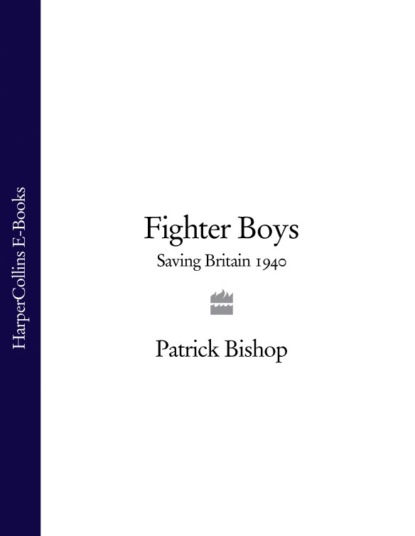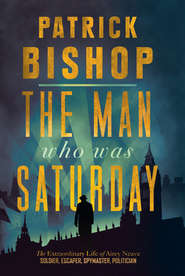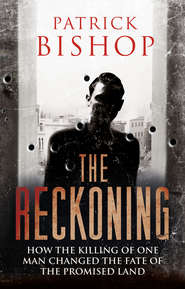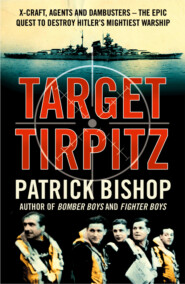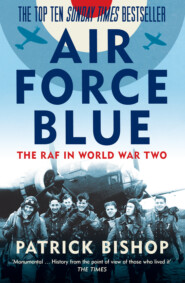По всем вопросам обращайтесь на: info@litportal.ru
(©) 2003-2024.
✖
Fighter Boys: Saving Britain 1940
Настройки чтения
Размер шрифта
Высота строк
Поля
(#litres_trial_promo) Peter Pease and Colin Pinckney, both old Etonians, had also joined the Cambridge University Air Squadron and both had been commissioned in the RAFVR by the end of 1938. They met Hillary during training and their subsequent intense and poetic triangular relationship was to be celebrated in the book.
The great variety of backgrounds and schools, the wide divergences of rank, wealth and privilege, made Fighter Command perhaps the most socially diverse élite ever seen in the British military. In a country where minutely defined social gradations conditioned the reactions of human beings to each other, the mingling of the classes caused some discomfort. The situation was described in a condescending bon mot: ‘Auxiliaries are gentlemen trying to be officers. Regulars are officers trying to be gentlemen. VRs are neither trying to be both.’ It was a last, snobbish gasp from a disappearing world. Very soon the distinction would not matter. It was true that many of the men in Fighter Command came from backgrounds that were ‘ordinary’. But that did not mean that they themselves were so; and they were about to do extraordinary things.
4 The Fatal Step (#ulink_64d4c67e-8922-5bab-8d94-3ec3304ef874)
The new pilots had been recruited to fly a new generation of fighter aeroplanes, but the machines were painfully slow in reaching the squadrons. The first Hurricanes did not appear in service until January 1938, when 111 Squadron became the first unit to receive them. It was August, and the eve of the Munich crisis, before 19 Squadron took delivery of the first Spitfires. At the end of the year most fighter squadrons were still flying biplanes.
Ronald Brown, the ex-Halton boy who had been selected for flying training, was a sergeant pilot at Northolt with 111 Squadron when the Hurricanes arrived. The squadron commander and flight commanders were the first to test them. Then it was the turn of the junior pilots. They were told to keep the undercarriage lowered in order to reduce speed. The great power of the Merlin engine, twice as potent as anything they had previously known, would take time to adjust to, it was thought. Brown, even though it was the first time he had handled a monoplane, in fact found it ‘quite an easy plane to fly’.
(#litres_trial_promo) Most pilots’ accounts of their experience of the Hurricane, however, reveal a mixture of trepidation and elation. Roland Beamont remembered ‘a feeling of exhilaration with all this power and being able to get up to 300 miles an hour on the air-speed indicator very easily in a shallow dive at any point in your flight. This was a great experience for an eighteen-year-old.’
(#litres_trial_promo) The Gloster Gauntlets and Gladiators, which represented the zenith of biplane fighter design and served as a stopgap with many fighter squadrons while the new monoplanes were brought in, could manage only 230 and 255 m.p.h. respectively.
For pilots used to biplanes, the Hurricane seemed to take a long time to get airborne. Initially it had a fixed-pitch, twin-bladed propeller that only allowed one setting. With variable-pitch propellers, which were soon to come in, the pilot put the airscrew in ‘fine’ for take-off. This provided less speed but more power, giving maximum thrust – the equivalent in motoring terms of first gear. Once aloft, the pilot changed to ‘coarse’, altering the angle of the propeller blade so that it was taking bigger bites out of the air, generating less power but more speed. Later both types would be fitted with constant-speed governors that adjusted the blade angles automatically. Beamont thought flying a Hurricane was ‘simple, straightforward’. Christopher Foxley-Norris found it reassuring. ‘You get into an aircraft and it gives you confidence. You get into another one and it doesn’t…[The Hurricane] was very stable but at the same time manoeuvrable. If you didn’t want it to do a turn it was absolutely rock stable. If you did turn it was very manoeuvrable.’
(#litres_trial_promo)
The Hurricane was slower than a Spitfire but could turn more tightly. Its wide-legged undercarriage, which opened outwards, planting the aeroplane firmly on the ground, made it ‘very forgiving’, another advantage over the Spitfire, which balanced on a narrow wheelbase. The initial canvas-and-girder construction of the fuselage meant bullets and cannon shells could go straight through it without bringing the aircraft down, and its sturdy wings provided solid bracing for the eight Brownings. It was, everyone said, an ‘excellent gun platform’, better, in fact, than the Spitfire. The machine guns were arranged in two groups of four, as close in to the fuselage as they could be placed to clear the propeller. The Spitfire’s armament was spread out, with the outboard gun a third of the way in from the wing-tip; then a group of two, then an inboard gun on each wing, which could cause some flexing when the guns fired, making them less accurate. The Hurricane was fast and nimble but honest. It was not quite perfect. Pete Brothers discovered ‘it could fall out of the air if you mistreated it trying to be too clever’.
The arrival of the new fighters aroused the fervent interest of newspapers and newsreel companies. Brown remembered them making ‘an absolute meal of the Hurricane. We were wonderboys, travelling at vast speeds, pulling all this G [the heavy gravitational force exerted when turning]. We were getting constant visits from the press and staff colleges who wanted to see these things in action.’
(#litres_trial_promo) Having appeared before the Spitfire, the Hurricane was the first to plant itself in the public imagination, though its primacy did not long survive the arrival of its more beautiful sister. The public perception that it represented a battle-winning technical advance was encouraged by a government and military establishment anxious to reassure citizens that the criticisms of the rearmament lobby were unfounded. Some pilots, used to the fixed wheels, open cockpits, broad flying surfaces and manageable speeds of the old types, wondered whether they would be able to cope. The difficulties which 111 Squadron had in making the transition were not reassuring. Some pilots simply could not adjust. Several were killed. One Australian pilot took off without realizing the wheel brakes were engaged. He only avoided crashing on take-off and landing because the field was so muddy the aeroplane slithered through the grass. When he made a subsequent landing without lowering the undercarriage, he was rapidly posted away.
Pilots liked the Hurricane’s chunky lines and solid profile. The lean, curved elegance of the Spitfire inspired something more profound. There was never ‘a plane so loved by pilots’, wrote Hugh Dundas.
(#litres_trial_promo) ‘Everybody wanted to fly a Spitfire,’ said Jeffrey Quill. ‘Most pilots used to want to fly the best. It certainly was the best.’ Quill knew the quality of the machine better than anyone. He was a test pilot at Supermarine and had taken the Spitfire through the most difficult stages of its development, as the design team struggled to overcome profound technical problems that were preventing it from making the evolutionary transition from being a very good aeroplane to a great one.
Quill was intelligent, shrewd and popular in both air force and civilian aviation circles, as much for his good nature as his superb abilities as a pilot. His father was Irish, an engineer who among other things had built Sierra Leone’s water system before retiring to Littlehampton in Sussex. He died in 1926 when Jeffrey was thirteen and a schoolboy at Lancing. As a young boy he watched the aeroplanes at the RFC base at Ford, near the family home. He decided early on to go into the air force, but he was the youngest of five children and there was little money. He had to forgo Cranwell, where his family would have had to support him for two years, and applied instead for a short-service commission. His first posting was to 17 Squadron, flying Bulldogs. Then he joined the Meteorological Flight at Duxford, which made daily sorties to take weather-forecasting readings, dangerous work that was given only to very good pilots. He hoped for a permanent RAF commission. But even in 1935, with expansion under way, his prospects were not sure and with some misgivings he accepted an offer to join Supermarine as an assistant to its chief test pilot, Mutt Summers, working on the Spitfire.
Progress was fitful. The prototype could not reach the 350 m.p.h. expected of it, only scraping up to 335 m.p.h. The propeller was one problem. It had been supplied by an outside contractor. A new one was designed by the Supermarine team and added an extra 13 m.p.h. Then the body surface was not smooth enough. Sinking rivets into the skin of the airframe would have brought better aerodynamic efficiency, but doing so would take much time and money. The team stuck split peas on the prototype to simulate round-headed rivets, which were much simpler to punch, then progressively removed them during aerodynamic tests to see which surfaces absolutely required flush rivets and which did not.
Failure to solve these problems and reach the performance levels Mitchell had claimed for his design could have meant the Spitfire never going into service. Quill and the rest of the team knew what was at stake. Later he revealed how close the decision had been. ‘A lot of people felt that the Spitfire, although it had a very good performance…had been bought at too high a price. In terms of ease of production it was going to be a much more expensive and difficult aeroplane to mass produce. In terms of the ease of maintenance it was going to be a much more complicated aeroplane to look after and service…For instance, you could lower the undercarriage of a Hurricane and take the wings off because the undercarriage was in the centre section…You could take the wings off, put the tail up on a three-ton lorry and tow it along the road. You couldn’t do that with a Spitfire. If you took the wings off…it took the undercarriage off as well…There were a lot of people who were against the Spitfire for those practical considerations. Therefore if we had not been able to show a really definite advantage over the Hurricane, it probably wouldn’t have been ordered. We were well aware of that.’
A final, crucial question had to be settled. In May 1936 a prototype was sent to the RAF Aircraft and Armament Establishment at Martlesham for trials by the service’s test pilots. Before the programme was complete, the research and development representative on the Air Council, Wilfred Freeman, asked the establishment’s flight commander Flight Lieutenant Humphrey Edwards-Jones, whether the Spitfire could be flown with relative ease by ordinary squadron pilots. ‘Old “E.-J.” quite rightly said, “Yes, it can,”’ Quill said later. On the strength of this judgement, before any performance testing had taken place, the decision to order was made. Quill reckoned there would have been ‘an awful delay if he’d hedged about that. It was one of the best things ever done.’
(#litres_trial_promo)
No. 19 Squadron had been chosen as the first unit to receive the Spitfire because of its record of superlative flying, demonstrated at displays around the country by an aerobatic team which performed such impressive but not necessarily militarily useful stunts as flying in rigid formation tied together with ropes. The five pilots selected to put the Spitfire through a 500-hour series of tests included two sergeants, George Unwin, the Ruislip apprentice, and his best friend Harry Steere. Unwin was particularly struck by the sensitivity of the controls. ‘There was no heaving or pulling and pushing and kicking, you just breathed on it. She really was the perfect flying machine. She hadn’t got a vice at all. She would only spin if you made her and she’d come straight out of it as soon as you applied opposite rudder and pushed the stick forward…I’ve never flown anything sweeter.’ The Spitfire’s engine note was instantly recognizable to those who had flown it, and distinct from that of a Hurricane, even though they both had the same Merlin power unit. Many years later Unwin was coming out of Boots in Bournemouth with his wife when he heard ‘that peculiar throaty roar…I said to her, “There’s a Spitfire somewhere.” A taxi driver was standing there and said, “There she is, mate.” It is a noise you will never forget.’
(#litres_trial_promo)
Brian Kingcome believed ‘it had all the best qualities an aircraft could have. It was docile, it was fast, it was manoeuvrable, it was gentle…it did everything you asked of it.’
(#litres_trial_promo) John Nicholas of 65 Squadron accompanied Kingcome to the Supermarine airfield at Eastleigh, Southampton, where Jeffrey Quill showed them the controls. He warned them that ‘everything was sensitive…it was so light on the controls, index finger and thumb would fly it’.
(#litres_trial_promo)
There were disadvantages, too, the first of which was immediately obvious at take-off. The undercarriage hydraulics were manual and the wheels had to be pumped up by lever with the right hand. There was a natural tendency to waggle the control column back and forth during the manoeuvre, and new pilots were recognizable by the way they pitched and yawed after they got airborne. This problem disappeared with the fitting of a power pump. It was easy to forget the propeller adjustments that had to be made to the Spitfire, the same as they did to the Hurricane. Brian Considine, a trainee executive with Unilever who joined the RAFVR at nineteen, had only flown fixed-pitch propeller biplanes when he was sent to join 238 Squadron at Tangmere. He was given one short trip in a single-wing Master trainer as preparation for his Spitfire debut. He ‘took off in fine pitch and promptly forgot to put it back into coarse pitch, and did a few circles round the field thinking how marvellous it was…I made a nice landing and as I taxied in I could see the CO jumping up and down like a monkey in a rage. When I got out he told me I had wrecked the thing. I hadn’t, but it was all covered in oil.’
(#litres_trial_promo)
The Spitfire had a very long nose, which allowed the pilot virtually no forward vision when tilted on the back wheel in the taxiing position. To see ahead it was necessary to swing the aircraft from side to side. The centre of gravity was also unusually far forward, so a heavy foot on the brakes would tip the machine on to its propeller. But these, the infatuated pilots believed, were foibles not faults. The Spitfire was certainly a better aeroplane than the Hurricane and at least the equal of its German rival, the Messerschmitt 109. The former it could out-climb and out-dive. The latter it could out-turn. It was still in service in its Mark XII incarnation at the end of the war when the Hurricane had been phased out and replaced by the Typhoon. Brian Kingcome judged that ‘the Hurricane was already more or less at the peak of its operational and design potential when it first came into service…its future was strictly limited by its rugged, uncouth airframe…The Spitfire, by contrast, possessed a unique capacity for development.’
(#litres_trial_promo)
None the less the competitive spirit that the RAF, and particularly Fighter Command, fostered meant that the Hurricane pilots were loyal to their machines, maintaining to the last that they would not have swapped them for a Spitfire if given the choice. No. 111 Squadron pilots had had to endure some mockery at the time it took them to master the new fighters and finish the 500 hours of testing. George Unwin remembered that, as soon as they could muster twelve aircraft, the first thing they did was to come down to 19 Squadron at Duxford to ‘beat up’ the aerodrome, as the RAF called the practice of flying low and fast over bases to impress their rivals – or show off to girlfriends. Once 19 Squadron was able to do so, it flew over to Northolt and returned the compliment.
The re-equipment programme went slowly, moving at the limited pace that peacetime industrial capacity allowed. By the late summer of 1938 it seemed alarmingly out of step with events. The Munich crisis of September 1938 showed how swiftly the RAF might be called upon to act, and how unprepared it was to do so. As it broke, there were just six squadrons equipped with Hurricanes, only half of which were combat-ready. No. 19 Squadron had only three Spitfires, which were armed with machine guns but lacked gunsights. The remaining sixteen operational squadrons had Gladiator, Gauntlet, Demon and Fury biplanes to oppose the sleek, modern might of the Luftwaffe.
As the crisis deepened, officers of 1 Squadron and 43 Squadron joined aircraftmen in the hangars to cover the gleaming silver paint that usually decorated the Furies – to show them to their best advantage in formation flying and aerobatics – with dismal shades of camouflage green and brown. Billy Drake and his comrades were ordered to sleep in the hangars, next to the aircraft to be at full readiness. No one knew quite what to expect. ‘I think we had an idea that they would go for us on the airfields, but nobody really seemed to have any strategy in mind – not at our level anyway.’
(#litres_trial_promo)
At Biggin Hill, 79 Squadron was recalled from leave and on 27 September the auxiliaries of 601 Squadron were summoned to move from Hendon to the station, which had been designated their wartime base. At Hornchurch, 54, 74 and 65 Squadrons were called to immediate readiness and some pilots slept in crew rooms close to the aircraft. No. 74 Squadron had to abandon a gunnery practice camp at Sutton Bridge in Lincolnshire and return home, where they obliterated the squadron badges and tiger stripes adorning the fuselages of their Gauntlets and Gladiators, mixing up the paint from the colours available in the stores when the green and brown ran out. Al Deere, now with 54 Squadron, found it ‘a heartrending operation having to desecrate one’s beautiful Gladiator’. With the return of Chamberlain, waving his assurance from Hitler, the crisis fizzled out. The sigh of relief that gusted across Britain was not shared by all. ‘It is callous and wrong to say it, but when “peace in our time” was agreed, I was horribly disappointed,’ Deere admitted later.
(#litres_trial_promo)
The likelihood of the Luftwaffe bombing Britain in the early autumn of 1938 was small, but the scare the crisis engendered was real and had the useful effect of speeding up the delivery of Hurricanes and Spitfires. The episode also blew away the last wisps of complacency that clung to the air force about what the future held. Politicians might maintain that this time Hitler could be trusted and a cataclysm had been averted rather than simply postponed. But many of the young pilots, and those who commanded them, now believed that a clash with the Luftwaffe was inevitable.
By the end of 1938 the Furies disappeared from Tangmere and Hurricanes took their place. Paul Richey arrived there in March 1939. He was in his twenty-third year and had been brought up in Switzerland, France and Albania, where his father, a veteran of the trenches, had helped to organize King Zog’s gendarmerie. He was commissioned in 1937 and already knew Tangmere from visits during training. Posted there to join No. 1 Squadron, he noted the new atmosphere.
Half the pilots in each squadron now had to be permanently available on station in case of a German attack. Gone were the carefree days when we would plunge into the cool blue sea at West Wittering and lie on the warm sand in the sun, or skim over the waters in Chichester harbour, in the squadron’s sailing dinghy, or drive down to the Old Ship at Bosham with the breeze in our hair and knock it back under the oak rafters. Our days were now spent in our Hurricanes at air drill, air firing, practice battle formations and attacks, dogfighting – and operating under ground control with the new super-secret RDF (the name then given to radar).
(#litres_trial_promo)
It was the same for everybody. The pleasant old arrangements of no flying after 4 p.m., and weekends and Wednesday afternoons off, were dropped and the tempo of practice and training quickened. The activity was intense but lacked direction and seemed curiously disconnected from the realities of aerial warfare as had been demonstrated by the German and Italian air forces in the skies over Spain. The preparations also seemed to lack consistency, with different squadrons following different programmes. It would soon become clear that some skills vital for success and survival in the changed conditions of air fighting were miserably under-taught and in some cases ignored altogether.
Tactical training before the war was based on two premises that would turn out to be fatally mistaken once the conflict began. The first of these was that close, tight formation flying concentrated force in such a way as to make fighters both more destructive and more secure. The second was the expectation that they would be facing fleets of bombers arriving in waves, capable of defending themselves with onboard guns but unprotected by escorting fighters. The logic of the assumption was that the Luftwaffe would be confined to its German bases and its Me 109s would not have the range to accompany the bombers.
Those who survived the war complained that the RAF had a drill-hall mentality, exalting the sort of flying discipline exemplified by 19 Squadron’s aerial rope trick. There was a useful point to close formation flying. It helped groups of aeroplanes to move through cloud without colliding or losing contact with each other. But good formation drill was also seen as the basis of good tactics. Al Deere wrote later that ‘the majority of our training in a pre-war fighter squadron was directed at achieving perfection in formation with a view to ensuring the success of the flight and squadron attacks we so assiduously practised’. These were known as Fighter Area Attacks, and were numbered from one to five, depending on the fighters’ line of approach and the number of bombers. Thus, No. 1 involved a section of three or a flight of six fighters attacking one after the other a single bomber from astern. In No. 2, two or more fighters attacked a single bomber in line abreast, and No. 3 envisaged three fighters coming at a single bomber simultaneously from rear, beam, and rear quarter. It was all very theoretical and, as it turned out, of little use. But theory was all there was to go on.
‘The order to attack was always preceded by the flight commander designating the number of the attack, viz. “FAA attack No. 5 – Go!”’ Deere wrote later. ‘These attacks provided wonderful training for formation drill, but were worthless when related to effective shooting. There was never sufficient time to get one’s sights on the target, the business of keeping station being the prime requirement.’
(#litres_trial_promo) Pete Brothers and the rest of 32 Squadron at Biggin Hill prepared for war by following rigid scenarios that proposed set responses to set situations, practising on ‘enemy bombers’ that flew stolidly on, disdaining to take any evasive action. ‘If there was a small number of bombers your twelve aircraft would be divided up into sections of three. Then three of you would have a go at one bomber, one after the other. If there was a large number, you would spread out into echelon starboard [diagonally] setting it all up and giving them plenty of warning you were coming. It must have been all theoretical because no one had actually fought in these conditions before.’
(#litres_trial_promo)
The tactics taught to George Unwin in 19 Squadron were ‘more suited to the Hendon air display’ than the realities of war. When put into practice for the first time over Dunkirk, the results were to be disastrous. The severe limitations of the pre-war tactical approach was to become apparent almost immediately, but this did not stop it being taught well into the war. Roger Hall, a young, pre-war professional soldier who transferred to the RAF, was posted to 152 Squadron at the height of the fighting in September 1940 after only a week’s operational training. He remembered during his instruction being ‘briefed on how to attack a bomber, but it was so perfunctory really that it was almost ludicrous.’ Three pilots were designated to take off in their newly acquired Spitfires and ‘attack’ a Wellington which was playing the role of an enemy bomber. Green though he was, Hall knew that ‘when you attack a hostile bomber they try to get out of the way. But this particular one was simply flying straight and level…The drill was to get above the bomber and the first Spitfire would come down and shoot its port engine and then it would break away. The next one would come and shoot the starboard, then that would break away. Then the third one would come down and shoot the body of the machine and then break away, but all the time the Wellington was just going straight and level, just asking for it…I used to laugh about that.’
(#litres_trial_promo)
Brian Kingcome recalled that ‘fighter versus fighter wasn’t really envisaged or catered for’, and the assumption was that if they did take place they would be ‘pretty much as they were in the First World War except that you had faster, better aircraft and the huge advantage of a parachute’. None the less individual pilots did get in unofficial practice, going off in pairs to chase each other around the sky.
(#litres_trial_promo)
The pilots who went into action for the first time in 1939 and 1940 might have known a lot about flying. They knew little, though, about how to fight in the air and less about how to shoot. Aerial gunnery was supposed to be taught as part of training and each regular fighter squadron was expected to go to an annual camp at one of the armament training stations for practice with live ammunition, shooting at drogues towed behind other aircraft, or at ground targets. This was occasionally supplemented by the use of camera guns, from which theoretical scores could be deduced. It was all a long way from reality.
In retrospect the amount of time spent on what was a fundamental air skill would seem desperately inadequate. ‘Looking back,’ Al Deere wrote afterwards, ‘I can see how dreadfully we neglected gunnery practice, live or by means of cine-films, and what an important part it plays in the part of a successful fighter pilot…squadron morale carried us safely through the early fighter battles of the war, not straight shooting.’





